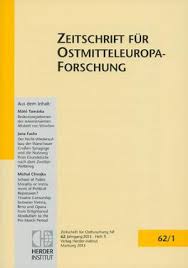„Preußen – das sind wir!“ Zur Wiederentdeckung der preußischen Kulturlandschaft in Deutschland und Polen
“Prussia – that is us!” The Rediscovery of the Prussian cultural landscape in Germany and Poland
Author(s): Gregor ThumSubject(s): Political history, Social history, WW II and following years (1940 - 1949), History of Communism
Published by: Verlag Herder-Institut
Keywords: “Prussia – that is us!”; Rediscovery; Prussian cultural landscape; Germany and Poland;
Summary/Abstract: Although the societies of Poland, the GDR and the Federal Republic of Germany differed in more than one way, their remembrance of Prussia followed strikingly similar trends and fulfilled similar political functions after 1945. The first two postwar decades saw the demonization of Prussia as a means of legitimizing the postwar political order. Prussia’s image as the epitome of authoritarianism and militarism in German history served as a counter-image for the Federal Republic and its project of political westernization; and it served the communist leadership of the GDR, which portrayed the GDR as a revolutionary state that broke with Prussia’s imperialist and feudal traditions. In Poland, the demonization of Prussia was a crucial element in the attempts to justify the incorporation of the German territories east of the Oder-Neisse line, all of which had been part of Prussia. With the stabilization of the postwar order, the demonization of Prussia lost in significance. In the seventies, historians of all three societies began to question the overly negative depiction of Prussia and promoted a more balanced view of its history. While the popular image of Prussia improved significantly in both German states, it remained largely negative in Poland. Here, the demonization of Prussia not only had a far longer tradition, but it also continued to be politically useful for the communist party. After the end of communism in Poland and the reunification of Germany, an upsurge in local initiatives to revitalize the cultural landscapes of Brandenburg, Pomerania, Masuria, and Silesia led to a rediscovery of Prussia’s material legacy in Germany and Poland. Although this did not lead to a re-glorification of the Prussian past, there is evidence of local attempts to embrace parts of this history. After all, the preservation and cultural development of those regions that have been shaped by their centuries-long affiliation with Prussia is dependent on a more positive image of the Hohenzollern state. This is particularly the case in Poland, where the condemnation of everything Prussian has a long tradition. Even though it is too early to assess the results of a current process, there are signs for a Polish rebranding of Prussia as an a-national state with a significant Polish component. These locally and regionally driven reinterpretations not only challenge established views in Poland but also popular perceptions in Germany, according to which Prussia was first and foremost a German state.
Journal: Zeitschrift für Ostmitteleuropa-Forschung
- Issue Year: 59/2010
- Issue No: 3
- Page Range: 301-322
- Page Count: 22
- Language: German

